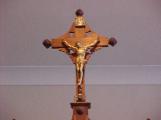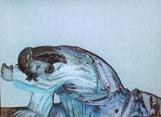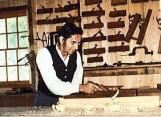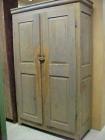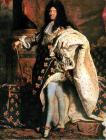14
The Quebec Settlement ExpandsFrom the earliest days of the Quebec post, the trees became the major building material used by the French. Wood even played a vital role in the success of the Canadian fur industry. The French fur traders, following the example of the country's Aboriginal population, travelled in canoes constructed of birch bark. The need for wood and wood workers, however, increased dramatically after 1619. By that time, Samuel de Champlain had succeeded in convincing the French King and his Ministers to allow people of various trades and their families to move from France to the Quebec settlement. Champlain had argued that such an increase in immigration to Canada would result in expanding the fur trade. Furthermore, Champlain held that new settlers with a variety of skills could introduce new industries to New France such as farming, mining, and lumbering which would be of great financial benefit to France.
After 1619, the King set out to create a real French colony in Canada. He started the project by making grants of land to French noblemen. The nobles who owned lots of land in what became the province of Quebec were known as "seigneurs" or Lords. The seigneurs allowed tenants or "habitants" - meaning people living in a particular place - to farm the land. The habitant farmer in turn paid a fee to his seigneur for the right to farm on the seigneur's land. People of other trades including teachers, shopkeepers, and priests also chose to begin a new life in Canada. By the mid 1600s, the rise in New France's population had resulted in the establishment of three towns, Quebec, Montreal, and Trois Rivieres. The fur trade remained the major industry in New France. First Nations traders the furs primarily to posts in Montreal and Trois Rivieres in exchange for tools, guns, and alcohol. The furs were then transported to France.
In spite of the fact that the arrival of people with a variety of skills strengthened the colony, the French settlers still faced hardships that came from being so far from their country of origin. Like Champlain's original group of twenty-eight, the new colonists were unable to transport much of their personal belongings due to the limited space offered by French ships. Only the wealthiest of passengers were able to pay the hefty expense of shipping large items such as furniture to their new homes. Therefore, many of the early colonists, especially those living away from the towns, were forced to learn how to work with wood. They had to craft their own plates and bowls to hold traditional French dishes such as tortiere and pea soup. The handmade wood furniture was generally very simple in design. The ordinary habitant lacked both time and formal training to do any fancy work. The arrival in Quebec of a persistent Bishop from France in the early 1670s, however, would soon transform this crude mode of wood crafting into a distinctly French Canadian art form.
16
Bishop Laval and the Master CarversThe growth in the population led to new challenges for the French church in New France. Since the vast majority of French Canadians were devout Roman Catholics, new Roman Catholic churches were needed to accommodate the faithful. During the 1st half of the 17th century, only one church existed to serve the settlers and the converts of the First Nations. By 1678, fourteen new parishes had been set up. Bishop Laval was sent from France to oversee the task of building the new churches. The Bishop firmly believed that these houses of worship must be decorated in manner that was worthy of God. Laval reasoned that a church filled with art would both inspire and educate the public. He recognized that it would be impossible to ship enough statues, altars, and other large objects from France to meet the demands of a large number of new stone churches.
The Bishop's solution was to offer contracts to highly trained woodcarvers, wood workers, masons, carpenters, and stone cutters from the mother country. Laval's scheme went beyond meeting the immediate needs of the new churches. He also decided to establish trade schools where the newcomers could pass on their craft to future generations. In September of 1675, the first step in Laval's plan was realized with the arrival of thirty craftsmen from France.
18
The First Arts and Crafts Schools of New FranceUnder the direction of Bishop Laval, two arts and crafts schools were constructed. The first was sited at Cape Tourmente and was known as the Saint-Joachime School of Arts and Crafts. Talented master sculptor, architect, and painter Jacques Leblond de Latour was engaged by Laval to run Saint-Joachime. The Quebec Seminary housed the second school. In addition to learning a trade, young boys received instruction in math, reading, and writing at the two schools. Of the two, Saint-Joachime became the best known for its excellent training in the art of sculpting. Most of the sculptors who decorated the churches during this period were trained at Saint-Joachime.
It soon became obvious that Bishop Laval's plan was a good one. The artisans who were brought to New France by Laval and their apprentices were responsible for a number of projects including a tabernacle for Saint Anne-de-Beaupré and an altar for the Quebec Seminary. With the aid of parishioners, they supplied a number of churches with candlesticks, chairs, statues, and vaults. Elaborate panel work, columns, brackets, and retables (panels behind altars) soon adorned churches in French Canada. While bronze and marble were popular materials with craftspeople in France, such materials were not available to their Canadian counterparts. Religious statues carved in New France consisted of wood that was often decorated with paint. Many of the statues were replicas of those made in France since small objects could easily be shipped from France. The figurines were made available to trained artists to be studied and copied. These craftsmen employed by the church in New France enjoyed a comfortable living. The Roman Catholic Church held the power to tax the people and spent a great deal of these funds decorating Quebec churches.
20
Expansion of Woodcarving and the Creation of French Canadian Folk ArtThe appearance of the formally trained artisan, known as "main de metiér," gave the wealthier colonists the opportunity to acquire stylish and sophisticated furniture. Both Montreal and Trois Rivieres established their own arts and crafts schools. The new schools added to the number of expert craftsmen in Quebec. Between 1650 and 1750, professional woodworkers carved elaborate furniture for their rich patrons in what was called the Louis XVI style, so-named after the French King. Furniture decorated with carved diamond points and multi-panelled chests were characteristic of the Louis XVI design. Even though master carvers modelled their work after pieces made in France, there were major differences in the Quebecois furniture. Furniture made in New France was rarely created just for decoration. They had to be simpler in design and sturdier for everyday use.
The majority of habitants probably could not afford the cost of hiring a main de metiér. As time went on, the number of shops manned by people who were schooled in woodcarving increased. Less well off townspeople might be able to find a woodworker whose fees were more reasonable. Besides making furniture, the professional woodworker might be called upon to make signs and figurines for the fronts of shops and hotels. These tradesmen also designed musical instruments such as violins. Most of the expert crafters were equally skilled in carving and carpentry.
Isolated country folk, on the other hand, had to be more self-sufficient. Although there were a few travelling woodworkers in Quebec, most rural habitants had to make their own household items. These untrained amateur craftsmen were identified as the "main fruste et robuste." The term "main fruste et robuste" referred to the amateur's hands as being 'unpolished' but strong. Both trained and untrained carvers were most likely to use wood from pine, yellow birch, and butternut trees. Those trees were easy to work with and were widely available in New France. Farmers spent most of their down time in the winter months constructing wood objects such as sleds, chairs, cupboards, chests, and crucifixes. Perhaps inspired by the art of the churches, the farmers manufactured wooden items that were both practical and attractive. The rural farmer also undertook larger projects such as log cabins and family shrines. This knowledge of wood crafting was passed on through the generations. What developed over decades was a folk art unique to French Canada. This tradition went along with the habitants who set out to settle new lands in North America, such as the Detroit River region.
22
Mini altar and a wood cross with mother of pearl.1940
Amherstburg, ON Canada
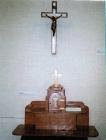 Credits:
Credits:Courtesy of Tony Rocheleau
23
Relief of Robert Cavelier Sieur de La Salle. Carved by Danny Curtis.1800
The Windsor Wood Carving Museum
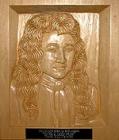
24
New France Moves to DetroitThe wood working skills developed in Quebec proved to be highly valuable when the government of France decided to set up a series of fortified trading centres in the Great Lakes region. This westward expansion was done for two reasons. The first was to take advantage of the supply of furs available in the area. The French government had been impressed with the skins that were acquired beyond the borders of Quebec. Unfortunately, travel to and from these outlying areas was full of peril. The french traders, known as the coureurs de bois (runners of the wood), who canoed to far away native villages to get furs found themselves in constant danger from the rapids and the lengthy land portages. It was more practical for the french to construct trading centres closer to their Aboriginal suppliers. The government's second motive was to halt entry of the British into the region. In order for these objectives to be met, it was crucial that the posts be occupied.
At one of the new posts, Fort Mackinac, a fateful decision was made. The site's Commandant, Antoine de Lamothe Cadillac, concluded that a french fort should be set up at the Detroit River. The french were already familiar with the region even before Cadillac argued his case to french officials. Back in 1669, french explorer Louis Joliet sailed up the Detroit River in his canoe. He was the first European to travel down the waterway. He found that the narrow strait allowed for a short voyage between its shores. The river also provided a connection between the St. Lawrence River and the Great Lakes. The French named the body of water "Detroit" which translates into "strait" in English.
Another French first was achieved by explorer Robert Cavelier de La Salle whose wooden ship, the Griffon, was the first vessel to sail the Great Lakes. La Salle's trip across the Great Lakes was but one achievement in his amazing career. He was born in France in the year 1643. While in his twenties, he moved to Montreal, bought land there, and became a fur trader. In time, he began to dream of finding a North American waterway to China. La Salle also schemed to win Mexico from Spain for France. He wanted his country to be more powerful than any other nation in the world. Although La Salle's ambition was never fully realized, he helped France gain new territory in North America. In 1680, he founded a French colony in what later became the state of Illinois. Two years later, La Salle acquired Louisiana for France. Tragically, his plan to establish a French settlement in present-day Missouri went horribly wrong. He and his party mistakenly landed at what later became the state of Texas in 1648 and found themselves stranded. La Salle's men finally lost confidence in their leader and killed him as they tried to return to Canada in 1687.
